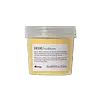What's inside
What's inside
 Key Ingredients
Key Ingredients

 Benefits
Benefits

 Concerns
Concerns

 Ingredients Side-by-side
Ingredients Side-by-side

Mangifera Indica Fruit Extract
Skin ConditioningPassiflora Incarnata Fruit Extract
Skin ConditioningCamellia Sinensis Leaf Extract
AntimicrobialSodium Cocoyl Isethionate
CleansingCoco-Betaine
CleansingSodium Methyl Cocoyl Taurate
CleansingSodium Cocoyl Glutamate
CleansingDisodium Cocoyl Glutamate
CleansingSodium Chloride
MaskingGlycerin
HumectantOenocarpus Bataua Seed Oil
EmollientPlukenetia Volubilis Seed Oil
EmollientSucrose
HumectantCocoyl Hydrolyzed Quinoa Protein
Mauritia Flexuosa Fruit Oil
Skin ConditioningKaolin
AbrasiveAroma
Cymbopogon Nardus Oil
MaskingLactic Acid
BufferingHydroxyethylcellulose
Emulsion StabilisingGlycine
BufferingCoco-Caprylate
EmollientXanthan Gum
EmulsifyingArginine
MaskingPotassium Sorbate
PreservativeGuar Hydroxypropyltrimonium Chloride
Skin ConditioningMangifera Indica Fruit Extract, Passiflora Incarnata Fruit Extract, Camellia Sinensis Leaf Extract, Sodium Cocoyl Isethionate, Coco-Betaine, Sodium Methyl Cocoyl Taurate, Sodium Cocoyl Glutamate, Disodium Cocoyl Glutamate, Sodium Chloride, Glycerin, Oenocarpus Bataua Seed Oil, Plukenetia Volubilis Seed Oil, Sucrose, Cocoyl Hydrolyzed Quinoa Protein, Mauritia Flexuosa Fruit Oil, Kaolin, Aroma, Cymbopogon Nardus Oil, Lactic Acid, Hydroxyethylcellulose, Glycine, Coco-Caprylate, Xanthan Gum, Arginine, Potassium Sorbate, Guar Hydroxypropyltrimonium Chloride
Water
Skin ConditioningCetearyl Alcohol
EmollientBehentrimonium Chloride
PreservativeGlycerin
HumectantHydroxypropyl Starch Phosphate
Cetrimonium Chloride
AntimicrobialOleic Acid
EmollientGlyceryl Stearate
EmollientDimethicone
EmollientBenzotriazolyl Dodecyl P-Cresol
UV AbsorberIsopropyl Alcohol
SolventBenzyl Alcohol
PerfumingParfum
MaskingPentaerythrityl Tetra-Di-T-Butyl Hydroxyhydrocinnamate
AntioxidantSclerotium Gum
Emulsion StabilisingPolyquaternium-6
Vp/Dmapa Acrylates Copolymer
Amodimethicone
Oryza Sativa Cera
Skin ConditioningDisodium EDTA
Sodium Benzoate
MaskingApium Graveolens Extract
Skin ConditioningBenzyl Salicylate
PerfumingLinalool
PerfumingCitronellol
PerfumingHydroxycitronellal
PerfumingCitric Acid
BufferingBenzalkonium Chloride
AntimicrobialCI 19140
Cosmetic ColorantCI 14700
Cosmetic ColorantWater, Cetearyl Alcohol, Behentrimonium Chloride, Glycerin, Hydroxypropyl Starch Phosphate, Cetrimonium Chloride, Oleic Acid, Glyceryl Stearate, Dimethicone, Benzotriazolyl Dodecyl P-Cresol, Isopropyl Alcohol, Benzyl Alcohol, Parfum, Pentaerythrityl Tetra-Di-T-Butyl Hydroxyhydrocinnamate, Sclerotium Gum, Polyquaternium-6, Vp/Dmapa Acrylates Copolymer, Amodimethicone, Oryza Sativa Cera, Disodium EDTA, Sodium Benzoate, Apium Graveolens Extract, Benzyl Salicylate, Linalool, Citronellol, Hydroxycitronellal, Citric Acid, Benzalkonium Chloride, CI 19140, CI 14700
Alternatives
Ingredients Explained
These ingredients are found in both products.
Ingredients higher up in an ingredient list are typically present in a larger amount.
Glycerin is already naturally found in your skin. It helps moisturize and protect your skin.
A study from 2016 found glycerin to be more effective as a humectant than AHAs and hyaluronic acid.
As a humectant, it helps the skin stay hydrated by pulling moisture to your skin. The low molecular weight of glycerin allows it to pull moisture into the deeper layers of your skin.
Hydrated skin improves your skin barrier; Your skin barrier helps protect against irritants and bacteria.
Glycerin has also been found to have antimicrobial and antiviral properties. Due to these properties, glycerin is often used in wound and burn treatments.
In cosmetics, glycerin is usually derived from plants such as soybean or palm. However, it can also be sourced from animals, such as tallow or animal fat.
This ingredient is organic, colorless, odorless, and non-toxic.
Glycerin is the name for this ingredient in American English. British English uses Glycerol/Glycerine.
Learn more about Glycerin